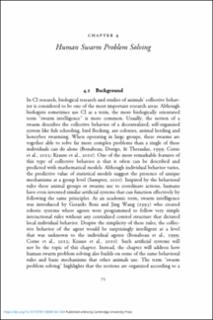| dc.contributor.author | Baltzersen, Rolf Kristian | |
| dc.date.accessioned | 2022-09-25T22:17:40Z | |
| dc.date.available | 2022-09-25T22:17:40Z | |
| dc.date.issued | 2022 | |
| dc.identifier.uri | https://hdl.handle.net/11250/3021110 | |
| dc.description | Chapter 4 in Cultural-historical perspectives on collective intelligence
In the era of digital communication, collective problem solving is increasingly important. Large groups can now resolve issues together in completely different ways, which has transformed the arts, sciences, business, education, technology, and medicine. Collective intelligence is something we share with animals and is different from machine learning and artificial intelligence. To design and utilize human collective intelligence, we must understand how its problem-solving mechanisms work. From democracy in ancient Athens, through the invention of the printing press, to COVID-19, this book analyzes how humans developed the ability to find solutions together. This wide-ranging, thought-provoking book is a game-changer for those working strategically with collective problem solving within organizations and using a variety of innovative methods. It sheds light on how humans work effectively alongside machines to confront challenges that are more urgent than what humanity has faced before. This title is also available as Open Access on Cambridge Core. | en_US |
| dc.description.abstract | Chapter 4 discusses human swarm problem solving as a distinct subtype of CI with biological antecedents in nest siting among honeybees and flocking behavior. Building on recent biological research, this chapter discusses five mechanisms that are also relevant for human swarm problem solving. These mechanisms are decision threshold methods, averaging, large gatherings, heterogeneous social interaction, and environmental sensing. Studies of collective animal behavior show that they often make decisions that build on statistical rules (e.g. averaging, threshold responses). Even when in a group, individuals will often seek and assess information independently of others with the intention of optimizing decisions through the “many wrongs principle” or the “many eyes principle.” Similarly, human ‘wisdom of the crowd’ studies examine similar statistical rules and principles like the importance of making independent contributions. However, while early research on the wisdom of crowds addressed the importance of independent contributions, newer studies also examine the possible positive influence of dependent contributions. The increasing variety of crowdsourcing studies are in this chapter explained with the framework of different swarm mechanisms. In the summary, four basic characteristics of human swarm problem solving are highlighted: predefined problems, pre-specified problem solving procedures, rapid time-limited problem solving, and individual learning. | en_US |
| dc.language.iso | eng | en_US |
| dc.publisher | Cambridge University Press | en_US |
| dc.rights | Attribution-NonCommercial-NoDerivatives 4.0 Internasjonal | * |
| dc.rights.uri | http://creativecommons.org/licenses/by-nc-nd/4.0/deed.no | * |
| dc.subject | Animals’ collective behavior | en_US |
| dc.subject | Wisdom of the crowd | en_US |
| dc.subject | Crowdsourcing methods | en_US |
| dc.subject | Decision threshold methods | en_US |
| dc.subject | Quorum responses | en_US |
| dc.subject | Majority rule | en_US |
| dc.subject | Referendum | en_US |
| dc.subject | Kickstarter | en_US |
| dc.subject | Voter competence | en_US |
| dc.subject | Voter independence | en_US |
| dc.subject | Averaging | en_US |
| dc.subject | Large gatherings | en_US |
| dc.subject | Waggle dance | en_US |
| dc.subject | Deliberative Polling | en_US |
| dc.subject | Hackathons | en_US |
| dc.subject | Swarm platform | en_US |
| dc.subject | Heterogeneous social interaction | en_US |
| dc.subject | Social learning | en_US |
| dc.subject | Group leadership | en_US |
| dc.subject | Centralized networks | en_US |
| dc.subject | Decentralized networks | en_US |
| dc.subject | The Delphi method | en_US |
| dc.subject | Environmental sensing | en_US |
| dc.subject | Disaster management | en_US |
| dc.subject | Smart cities | en_US |
| dc.subject | Predefined problems | en_US |
| dc.subject | Prespecified problem solving procedures | en_US |
| dc.subject | Rapid time-limited problem solving | en_US |
| dc.subject | Individual learning | en_US |
| dc.title | Human Swarm Problem Solving | en_US |
| dc.type | Chapter | en_US |
| dc.description.version | publishedVersion | en_US |
| dc.rights.holder | Rolf K. Baltzersen | en_US |
| dc.source.pagenumber | 75-134 | en_US |
| dc.identifier.doi | 10.1017/9781108981361.004 | |

